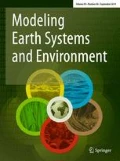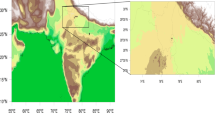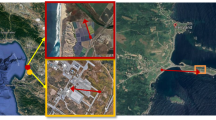Abstract
The campaign mode observational program 'Winter Fog Experiment' (WiFEX) was set up at the Indira Gandhi International Airport (IGIA), New Delhi, during the winter months of 2016–17 and 2017–18. Using the WiFEX data, in this study, we examine the microphysical structure of fog formed in a polluted environment and attempt to predict visibility (Vis) using the fog index approach. The examination of eleven fog events demonstrates that the mean droplet concentration (up to 674.94 #/cm−3) and liquid water content (LWC, up to 0.29 g m−3) are high in dense fog cases (Vis < 200 m). The droplet spectrum shows bi-modal distribution and dominance of smaller droplets in the 3–7 µm range. For most fog cases, the droplet spectrum extends up to 50 µm. The mature phase of the fog depicts a relatively increased population of droplets in the higher-sized bins, highlighting the formation of larger droplets. Moreover, we found that Vis is inversely related to the liquid water content and the fog droplet number concentration. Fog index-based visibility parameterization has been developed to diagnostically compute visibility for the different categories of fog events, namely category-IIIB (CAT-IIIB) and category-IIIC (CAT-IIIC), using the meteorological variables. Out of 14 CAT-IIIB and 19 CAT-IIIC fog events, the 'WiFEX-in' could predict seven CAT-IIIB and 12 CAT-IIIC fog events, respectively. However, significant under-prediction was evident for the total CAT-IIIB fog hours and over-prediction for the total CAT-IIIC fog hours. It is found that the observed and predicted fog hour differences were related to the errors in the fog onset, dissipation, and magnitude of predicted liquid water content during CAT-IIIB and CAT-IIIC events and the same are discussed.











Similar content being viewed by others
References
Collins WD, Rasch PJ, Boville BA, Hack JJ, Williamson DL, Kiehl JT, Briegleb B, Bitz CM, Lin S-J, Zhang M, Dai Y (2004) Description of the NCAR community atmosphere model (CAM 3.0). Ncar/Tn-464+Str
Croft PJ, Pfost RL, Medlin JM, Johnson GA (1997) Fog forecasting for the southern region: a conceptual model approach. Weather Forecast 12(3):545–556. https://doi.org/10.1175/1520-0434(1997)012%3c0545:FFFTSR%3e2.0.CO;2
Dhangar NG, Lal DM, Ghude SD et al (2021) On the conditions for onset and development of fog over New Delhi: an observational study from the WiFEX. Pure Appl Geophys 178:3727–3746. https://doi.org/10.1007/s00024-021-02800-4
Dimitrova R, Sharma A, Fernando HJS et al (2021) Simulations of coastal fog in the Canadian Atlantic with the weather research and forecasting model. Bound-Layer Meteorol 181:443–472. https://doi.org/10.1007/s10546-021-00662-w
Elias T, Dupont JC, Hammer E, Hoyle CR, Haeffelin M, Burnet F, Jolivet D (2015) Enhanced extinction of visible radiation due to hydrated aerosols in mist and fog. Atmos Chem Phys 15(12):6605–6623. https://doi.org/10.5194/acp-15-6605-2015
Fernando HJ, Gultepe I, Dorman C, Pardyjak E, Wang Q, Hoch SW, Wauer B (2021) C-FOG: life of coastal fog. Bull Am Meteor Soc 102(2):E244–E272. https://doi.org/10.1175/BAMS-D-19-0070.1
Ghude SD, Bhat GS, Prabhakaran T, Jenamani RK, Chate DM, Safai PD, Rajeevan M (2017) Winter fog experiment over the Indo-Gangetic plains of India. Curr Sci 112:767–784. https://doi.org/10.18520/cs/v112/i04/767-784
Gultepe I, Isaac GA (1999) Scale effects on averaging of cloud droplet and aerosol number concentrations: Observations and models. J Clim 12(5):1268–1279. https://doi.org/10.1175/1520-0442(1999)012%3c1268:SEOAOC%3e2.0.CO;2
Gultepe I, Milbrandt J (2007) Microphysical observations and mesoscale model simulation of a warm fog case during FRAM project. In: Gultepe I (ed) Fog and boundary layer clouds: fog visibility and forecasting. Pageoph topical volumes. Birkhäuser, Basel
Gultepe I, Heymsfield AJ, Lenschow DH (1990) A comparison of vertical velocity in cirrus obtained from aircraft and lidar divergence measurements during FIRE. J Atmos Oceanic Tech 7(1):58–67. https://doi.org/10.1175/1520-0426(1990)007%3c0058:ACOVVI%3e2.0.CO;2
Gultepe I, Müller MD, Boybeyi Z (2006) A new visibility parameterization for warm-fog applications in numerical weather prediction models. J Appl Meteorol Climatol 45(11):1469–1480. https://doi.org/10.1175/JAM2423.1
Gultepe I, Tardif R, Michaelides SC, Cermak J, Bott A, Bendix J, Cober SG (2007) Fog research: A review of past achievements and future perspectives. Pure Appl Geophys 164(6):1121–1159. https://doi.org/10.1007/s00024-007-0211-x
Gultepe I, Pearson G, Milbrandt JA, Hansen B, Platnick S, Taylor P, Cober SG (2009) The fog remote sensing and modeling field project. Bull Am Meteor Soc 90(3):341–360. https://doi.org/10.1175/2008BAMS2354.1
Gultepe I, Heymsfield AJ, Fernando HJS et al (2021) A review of coastal fog microphysics during C-FOG. Bound-Layer Meteorol 181:227–265. https://doi.org/10.1007/s10546-021-00659-5
Guyot G, Gourbeyre C, Febvre G, Shcherbakov V, Burnet F, Dupont J-C, Sellegri K, Jourdan O (2015) Quantitative evaluation of seven optical sensors for cloud microphysical measurements at the Puy-de-Dôme Observatory, France. Atmos Meas Tech 8:4347–4367. https://doi.org/10.5194/amt-8-4347-2015
Haeffelin M, Bergot T, Elias T, Tardif R, Carrer D, Chazette P, Zhang X (2010) PARISFOG: shedding new light on fog physical processes. Bull Am Meteor Soc 91(6):767–783. https://doi.org/10.1175/2009BAMS2671.1
Hammer E, Gysel M, Roberts GC, Elias T, Hofer J, Hoyle CR, Weingartner E (2014) Size-dependent particle activation properties in fog during the ParisFog 2012/13 field campaign. Atmos Chem Phys 14(19):10517–10533. https://doi.org/10.5194/acp-14-10517-2014
Heintzenberg J (1992) The Po Valley Fog experiment 1989 what have we learned, where do we go from here? Tellus B 44(5):443–447. https://doi.org/10.1034/j.1600-0889.1991.t01-3-00002.x-i1
Hong S, Lim J (2006) The WRF single-moment 6-class microphysics scheme (WSM6). J Korean Meteorol Soc 42:129–151
Jiusto JE (1981) Fog structure. In: Hobbs PV, Deepak A (eds) Clouds, their formation, optical properties, and effects. Academic Press, pp 187–239
Kulkarni R, Jenamani RK, Pithani P, Konwar M, Nigam N, Ghude SD (2019) Loss to aviation economy due to winter fog in New Delhi during the winter of 2011–2016. Atmosphere 10(4):198. https://doi.org/10.3390/atmos10040198
Kunkel BA (1984) Parameterisation of droplet terminal velocity and extinction coefficient in fog models. J Appl Meteorol Climatol 23(1):34–41. https://doi.org/10.1175/1520-0450(1984)023%3c0034:PODTVA%3e2.0.CO;2
Leng C, Zhang Q, Zhang D, Xu C, Cheng T, Zhang R, Gao W (2014) Variations of cloud condensation nuclei (CCN) and aerosol activity during fog–haze episode: a case study from Shanghai. Atmos Chem Phys 14(22):12499–12512. https://doi.org/10.5194/acp-14-12499-2014,2014
Liu X, Gu J, Li Y, Cheng Y, Qu Y, Han T, Zhang Y (2013) Increase of aerosol scattering by hygroscopic growth: Observation, modeling, and implications on visibility. Atmos Res 132:91–101. https://doi.org/10.1016/j.atmosres.2013.04.007
Liu D, Li Z, Yan W et al (2017) Advances in fog microphysics research in China. Asia-Pacific J Atmos Sci 53:131–148. https://doi.org/10.1007/s13143-016-0028-6
Liu Q, Wang ZY, Wu BG, Nie HH, Chen DH, Gultepe I (2021) Microphysics of fog bursting in polluted urban air. Atmos Environ 253:118357. https://doi.org/10.1016/j.atmosenv.2021.118357
Lu C, Liu Y, Niu S et al (2013) Examination of microphysical relationships and corresponding microphysical processes in warm fogs. Acta Meteorol Sin 27:832–848. https://doi.org/10.1007/s13351-013-0610-0
Maalick Z, Kühn T, Korhonen H, Kokkola H, Laaksonen A, Romakkaniemi S (2016) Effect of aerosol concentration and absorbing aerosol on the radiation fog life cycle. Atmos Environ 133:26–33. https://doi.org/10.1016/j.atmosenv.2016.03.018
Mazoyer M, Burnet F, Denjean C (2022) Experimental study on the evolution of droplets size distribution during the fog life cycle. Atmos Chem Phys Discuss. https://doi.org/10.5194/acp-2021-1027
Meyer MB, Lala GG, Jiusto JE (1986) FOG-82: A cooperative field study of radiation fog. Bull Am Meteor Soc 67(7):825–832. https://doi.org/10.1175/1520-0477(1986)067%3c0825:FACFSO%3e2.0.CO;2
Nakanishi M, Niino H (2006) An improved Mellor-Yamada Level-3 model: Its numerical stability and application to a regional prediction of advection fog. Bound-Layer Meteorol. https://doi.org/10.1007/s10546-005-9030-8
Niu S, Lu C, Liu Y, Zhao L, Lü J, Yang J (2010) Analysis of the microphysical structure of heavy fog using a droplet spectrometer: a case study. Adv Atmos Sci 27(6):1259–1275. https://doi.org/10.1007/s00376-010-8192-6
Niu SJ, Liu DY, Zhao LJ, Lu CS, Lü JJ, Yang J (2012) Summary of a 4-year fog field study in northern Nanjing, Part 2: fog microphysics. Pure Appl Geophys 169(5):1137–1155. https://doi.org/10.1007/s00024-011-0344-9
Parde AN, Ghude SD, Sharma A, Dhangar NG, Govardhan G, Wagh S, Jenamani RK, Pithani P, Chen F, Rajeevan M, Niyogi D (2022) Improving simulation of the fog life cycle with high-resolution land data assimilation: a case study from WiFEX. Atmos Res 278:106331. https://doi.org/10.1016/j.atmosres.2022.106331
Peng Y, Wang H, Hou M, Jiang T, Zhang M, Zhao T, Che H (2020) Improved method of visibility parameterization focusing on high humidity and aerosol concentrations during fog–haze events: application in the GRAPES_CAUCE model in Jing-Jin-Ji. China Atmos Environ 222:117139. https://doi.org/10.1016/j.atmosenv.2019.117139
Pilié RJ, Mack EJ, Kocmond WC, Rogers CW, Eadie WJ (1975) The life cycle of valley fog Part I Micrometeorological characteristics. J Appl Meteorol Climatol 14(3):347–363. https://doi.org/10.1175/1520-0450(1975)014%3c0347:TLCOVF%3e2.0.CO;2
Pithani P, Ghude SD, Chennu VN, Kulkarni RG, Steeneveld GJ, Sharma A, Prabhakaran T, Chate DM, Gultepe I, Jenamani RK, Madhavan R (2019a) WRF model prediction of a dense fog event occurred during the winter fog experiment (WIFEX). Pure Appl Geophys 176:1827–1846. https://doi.org/10.1007/s00024-018-2053-0
Pithani P, Ghude SD, Prabhakaran T, Karipot A, Hazra A, Kulkarni R, Chowdhuri S, Resmi EA, Konwar M, Murugavel P, Safai PD, Chate DM, Tiwari Y, Jenamani RK, Rajeevan M (2019b) WRF model sensitivity to choice of PBL and microphysics parameterization for an advection fog event at Barkachha, rural site in the Indo-Gangetic basin, India. Theor Appl Climatol 136:1099–1113. https://doi.org/10.1007/s00704-018-2530-5
Pithani P, Ghude SD, Jenamani RK, Biswas M, Naidu CV, Debnath S, Kulkarni R, Dhangar NG, Jena C, Hazra A, Phani R, Mukhopadhyay P, Prabhakaran T, Nanjundiah RS, Rajeevan M (2020) Real-time forecast of dense fog events over Delhi: the performance of the wrf model during WiFEX field campaign. Weather Forecast. https://doi.org/10.1175/waf-d-19-0104.1
Poku C, Ross AN, Blyth AM, Hill AA, Price JD (2019) How important are aerosol–fog interactions for the successful modelling of nocturnal radiation fog? Weather 74(7):237–243. https://doi.org/10.1002/wea.3503
Price J (2011) Radiation fog. Part I: observations of stability and drop size distributions. Boundary-Layer Meteorol 139(2):167–191. https://doi.org/10.1007/s10546-010-9580-2
Price JD, Lane S, Boutle IA, Smith DKE, Bergot T, Lac C, Clark R (2018) LANFEX: a field and modeling study to improve our understanding and forecasting of radiation fog. Bull Am Meteor Soc 99(10):2061–2077. https://doi.org/10.1175/BAMS-D-16-0299.1
Singh A, Dey S (2012) Influence of aerosol composition on visibility in megacity Delhi. Atmos Environ 62:367–373. https://doi.org/10.1016/j.atmosenv.2012.08.048
Spiegel JK, Zieger P, Bukowiecki N, Hammer E, Weingartner E, Eugster W (2012) Evaluating the capabilities and uncertainties of droplet measurements for the fog droplet spectrometer (FM-100). Atmos Measure Techniques 5(9):2237–2260. https://doi.org/10.5194/amt-5-2237-2012
Twomey S (1977) The influence of pollution on the shortwave albedo of clouds. J Atmos Sci 34:1149–1152. https://doi.org/10.1175/1520-0469(1977)034%3c1149:TIOPOT%3e2.0.CO;2
Wagh S, Krishnamurthy R, Wainwright C et al (2021) Study of stratus-lowering marine-fog events observed during C-FOG. Bound-Layer Meteorol 181:317–344. https://doi.org/10.1007/s10546-021-00670-w
Zhao L, Niu S, Zhang Y, Xu F (2013) Microphysical characteristics of sea fog over the east coast of Leizhou Peninsula, China. Adv Atmosp Sci 30(4):1154–1172. https://doi.org/10.1007/s00376-012-1266-x
Acknowledgements
We thank the Director, Indian Institute of Tropical Meteorology (IITM), Pune; Director-General, India Meteorological Department, New Delhi, for their encouragement and support during WIFEX. We also thank the Ministry of Earth Sciences, Government of India; (MoES), and Grandhi Mallikarjuna Rao (G.M.R.) group and Airports Authority of India (A.A.I.) for providing logistic support and cooperation to experiment IGIA, New Delhi. We appreciate help from Dr Jenamani for extending help to the carryout campaign at IGIA and Prakash Rao for sharing the model output. We also thank Dr Duncan Axisa (NCAR, USA) and Dr Darrel Baumgardner (DMT, Boulder, Colorado, USA) for valuable advice on the Fog Monitor and timely help.
Author information
Authors and Affiliations
Corresponding author
Ethics declarations
Conflict of interest
On behalf of all authors, the corresponding author states that there is no conflict of interest.
Additional information
Publisher's Note
Springer Nature remains neutral with regard to jurisdictional claims in published maps and institutional affiliations.
Rights and permissions
Springer Nature or its licensor holds exclusive rights to this article under a publishing agreement with the author(s) or other rightsholder(s); author self-archiving of the accepted manuscript version of this article is solely governed by the terms of such publishing agreement and applicable law.
About this article
Cite this article
Wagh, S., Kulkarni, R., Lonkar, P. et al. Development of visibility equation based on fog microphysical observations and its verification using the WRF model. Model. Earth Syst. Environ. 9, 195–211 (2023). https://doi.org/10.1007/s40808-022-01492-6
Received:
Accepted:
Published:
Issue Date:
DOI: https://doi.org/10.1007/s40808-022-01492-6




